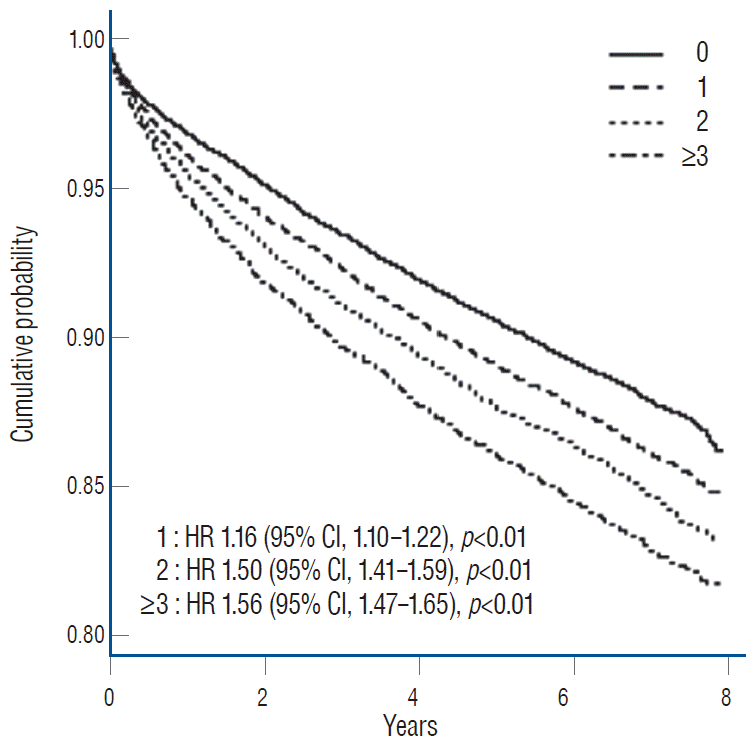1. Alpantaki K, Kampouroglou A, Koutserimpas C, Effraimidis G, Hadjipavlou A. Diabetes mellitus as a risk factor for intervertebral disc degeneration: a critical review. Eur Spine J. 28:2129–2144. 2019.

2. Alvarez-Garcia O, Matsuzaki T, Olmer M, Masuda K, Lotz MK. Age-related reduction in the expression of FOXO transcription factors and correlations with intervertebral disc degeneration. J Orthop Res. 35:2682–2691. 2017.

3. Boukhenouna S, Wilson MA, Bahmed K, Kosmider B. Reactive oxygen species in chronic obstructive pulmonary disease. Oxid Med Cell Longev. 2018:5730395. 2018.

4. Chen Z, Xie P, Feng F, Chhantyal K, Yang Y, Rong L. Decompression alone versus decompression and fusion for lumbar degenerative spondylolisthesis: a meta-analysis. World Neurosurg. 111:e165–e177. 2018.

5. Cheng CY, Cheng YC, Wang TC, Yang WH. Fusion Techniques are related to a lower risk of reoperation in lumbar disc herniation: a 5-year observation study of a nationwide cohort in Taiwan. World Neurosurg. 117:e660–e668. 2018.

6. Cheung PWH, Fong HK, Wong CS, Cheung JPY. The influence of developmental spinal stenosis on the risk of re-operation on an adjacent segment after decompression-only surgery for lumbar spinal stenosis. Bone Joint J. 101-B:154–161. 2019.

7. El Shahawy MS, Hemida MH, El Metwaly I, Shady ZM. The effect of vitamin D deficiency on eradication rates of Helicobacter pylori infection. JGH Open. 2:270–275. 2018.

8. Fabiane SM, Ward KJ, Iatridis JC, Williams FM. Does type 2 diabetes mellitus promote intervertebral disc degeneration? Eur Spine J. 25:2716–2720. 2016.

9. Feng Y, Egan B, Wang J. Genetic factors in intervertebral disc degeneration. Genes Dis. 3:178–185. 2016.

10. Gerling MC, Leven D, Passias PG, Lafage V, Bianco K, Lee A, et al. Risk factors for reoperation in patients treated surgically for degenerative spondylolisthesis: a subanalysis of the 8-year data from the SPORT trial. Spine (Phila Pa 1976). 42:1559–1569. 2017.

11. Gordon M, Stark A, Sköldenberg OG, Kärrholm J, Garellick G. The influence of comorbidity scores on re-operations following primary total hip replacement: comparison and validation of three comorbidity measures. Bone Joint J. 95-B:1184–1191. 2013.
12. Hong X, Liu L, Bao J, Shi R, Fan Y, Wu X. Characterization and risk factor analysis for reoperation after microendoscopic diskectomy. Orthopedics. 38:e490–e496. 2015.

13. Huang H, Cheng S, Zheng T, Ye Y, Ye A, Zhu S, et al. Vitamin D retards intervertebral disc degeneration through inactivation of the NF-κB pathway in mice. Am J Transl Res. 11:2496–2506. 2019.
14. Kim CH, Chung CK, Shin S, Choi BR, Kim MJ, Park BJ, et al. The relationship between diabetes and the reoperation rate after lumbar spinal surgery: a nationwide cohort study. Spine J. 15:866–874. 2015.

15. Kim JA, Yoon S, Kim LY, Kim DS. Towards actualizing the value potential of Korea Health Insurance Review and Assessment (HIRA) data as a resource for health research: strengths, limitations, applications, and strategies for optimal use of HIRA data. J Korean Med Sci. 32:718–728. 2017.

16. Kim L, Kim JA, Kim S. A guide for the utilization of Health Insurance Review and Assessment service national patient samples. Epidemiol Health. 36:e2014008. 2014.

17. Liu C, Zhang JF, Sun ZY, Tian JW. Bioinformatics analysis of the gene expression profiles in human intervertebral disc degeneration associated with inflammatory cytokines. J Neurosurg Sci. 62:16–23. 2018.

18. Ma K, Chen S, Li Z, Deng X, Huang D, Xiong L, et al. Mechanisms of endogenous repair failure during intervertebral disc degeneration. Osteoarthritis Cartilage. 27:41–48. 2019.

19. Radcliff K, Curry P, Hilibrand A, Kepler C, Lurie J, Zhao W, et al. Risk for adjacent segment and same segment reoperation after surgery for lumbar stenosis: a subgroup analysis of the Spine Patient Outcomes Research Trial (SPORT). Spine (Phila Pa 1976). 38:531–539. 2013.

20. Sato S, Yagi M, Machida M, Yasuda A, Konomi T, Miyake A, et al. Reoperation rate and risk factors of elective spinal surgery for degenerative spondylolisthesis: minimum 5-year follow-up. Spine J. 15:1536–1544. 2015.

21. Sundararajan V, Henderson T, Perry C, Muggivan A, Quan H, Ghali WA. New ICD-10 version of the Charlson comorbidity index predicted inhospital mortality. J Clin Epidemiol. 57:1288–1294. 2004.

22. Suzuki S, Fujita N, Hosogane N, Watanabe K, Ishii K, Toyama Y, et al. Excessive reactive oxygen species are therapeutic targets for intervertebral disc degeneration. Arthritis Res Ther. 17:316. 2015.

23. Zhang Y, Zhao Y, Wang M, Si M, Li J, Hou Y, et al. Serum lipid levels are positively correlated with lumbar disc herniation--a retrospective study of 790 Chinese patients. Lipids Health Dis. 15:80. 2016.

24. Zhong ZM, Deviren V, Tay B, Burch S, Berven SH. Adjacent segment disease after instrumented fusion for adult lumbar spondylolisthesis: incidence and risk factors. Clin Neurol Neurosurg. 156:29–34. 2017.






 PDF
PDF Citation
Citation Print
Print




 XML Download
XML Download